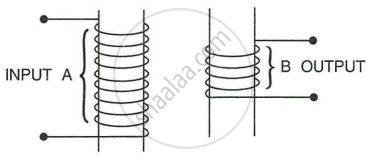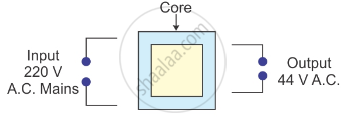Advertisements
Advertisements
Question
- Complete the following diagram of a transformer and name the parts labelled A and B.
- Name the part you have drawn to complete the diagram in part (a).
- What is the material of this part named above?
- Is this transformer a step up or step down? Give reason.

Solution
- A is the primary coil. B is the secondary coil.

- We have drawn laminated core in the diagram.
- The material of this part is soft iron.
- This transformer a step-down transformer because the number of turns in primary coil is much greater than that in the secondary coil.
APPEARS IN
RELATED QUESTIONS
Draw a labelled diagram to show the various components of a step-up transformer.
Name the principal on which step up transformer works.
The following diagram shows the core of a transformer and its input and output connections.

- State the material used for core and describe its structure.
- Complete the diagram of the transformer and connections by labelling all parts joined by you.
- Name the transformer: step-up or step down?
In a step-up transformer, the number of turns in the primary are ______ than the number of turns in the secondary.
Give two points of difference between a step-up transformer and step-down transformer.
Explain two types of transformer.
Below is the diagram of a transformer:

- Identify the type of transformer.
- In this type of transformer which of the wire is thicker, the primary or the secondary? Give a reason.
A transformer is used to change a high alternating e.m.f. to a low alternating e.m.f. of the same frequency.
State whether the turns ratio of the above transformer is = 1 or > 1 or < 1.
The output current of a transformer in which the voltage is stepped down is usually higher than the input current. Explain why.
Name the tranformer used in the power sub-station, state the function of each transfomer.
